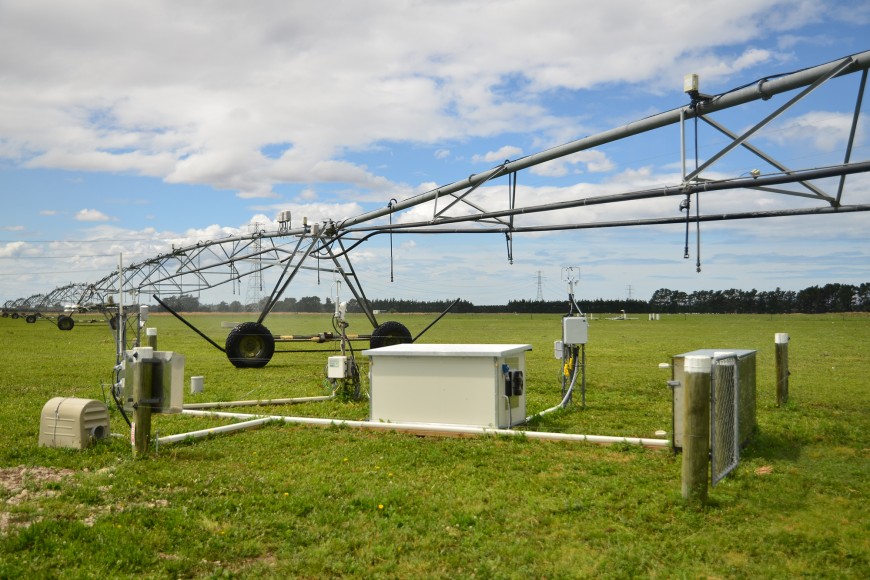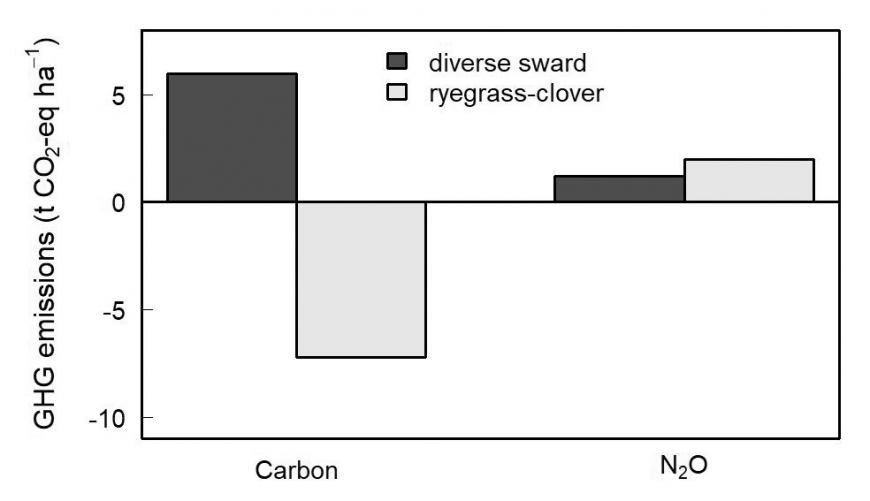Diverse pasture reduces nitrous oxide emissions – but there’s a catch!
As New Zealand works toward a low-carbon future there is a critical need to reduce greenhouse gas (GHG) emissions, particularly from livestock grazing systems. While methane emissions of livestock are well-recognised, another contribution to GHG emissions is nitrous oxide (N2O) lost from the soil as a fraction of the nitrogen (N) added to paddocks as fertiliser, from dairy shed effluent, or deposited by the animals as dung and urine.

Photo: Measurement system for CO2 and N2O exchange in an irrigated paddock at the Ashley Dene Research & Development Station. The white box in the centre contains a multi-gas analyser; the mast to its right holds a sonic anemometer (to measure the turbulent air movement) and an intake tube for a continuous stream of sample air, which is pumped into the gas analyser. To calculate the net carbon balance, the CO2 exchange measurements are combined with measurements of biomass removal from grazing and additions of effluent, excreta, and fertilisers to the pasture. Photo: John Hunt
Further, intensive management practices, such as irrigation, can lead to losses of soil carbon (C), which also constitute net GHG emissions. One promising mitigation approach for reducing N2O emissions and increasing the C balance of pastures is to use more diverse swards that include plant species with useful functional characteristics: increased winter growth and deeper root systems to allocate more C below ground, and production of biological nitrification inhibitors to restrict one N2O-producing pathway. Controlled small-plot experiments have identified plant species providing these effects, in ideal conditions. However, paddock-scale measurements are needed to fully capture the complex effects of plant species combinations, their spatial variability, and real-world pasture management on net GHG emissions.
Following completion of a 5-year MBIE-funded study of paddock-scale C and N losses from lucerne at the Lincoln University Ashley Dene Research & Development Station, we upgraded our instrumentation to include a new multi-gas analyser capable of measuring paddock-scale exchanges of N2O in addition to CO2 by the eddy covariance method (Photo). As part of a New Zealand Greenhouse Gas Research Centre-funded collaboration between Manaaki Whenua – Landcare Research and the University of Waikato, we located our instruments close to the boundary between two adjacent paddocks: one planted in traditional perennial ryegrass-white clover; the other planted with a 5-species mix also including winter-active Italian ryegrass, deep-rooted red clover, and plantain, which is known to reduce urinary N concentration in cows and N2O emissions. The location at the paddock boundary meant that with different wind directions we captured the gas exchange from each sward, at different times. Using sophisticated gap-filling approaches allowed us to construct complete records of N2O emissions and C balance for both paddocks with the same measurement system: the so-called ‘split footprint’ approach.

Figure 1: Cumulative carbon losses and nitrous oxide emissions (in CO2 equivalents) of a diverse sward and a traditional ryegrass-clover over the 2-year study period at the Ashley Dene Research & Development Station. Negative values indicate net uptake (carbon gain), while positive values indicate net greenhouse gas emissions.
We found a 39% reduction in N2O emissions from the diverse pasture relative to ryegrass-clover over two years of continuous measurements. This reduction is consistent with N2O reduction measured for swards containing plantain using chamber-based approaches, although attribution of the reduction effect to a single variable at our site is difficult. In contrast to N2O, there was a loss of C from the diverse sward over the 2-year study, while the ryegrass-clover gained C (Figure). When considering both N2O and C balance together (in CO2-equivalent units), the difference in C balance between the two swards exceeded the difference in N2O emissions between them. Consequently, the total net GHG emissions were lower for the ryegrass-clover. These findings demonstrate the value of measuring multiple environmental indicators when considering mitigation approaches, as there can be trade-offs. However, we cannot discount the value of diverse pastures based on these results as the C balance is variable through time and is extremely sensitive to grazing management decisions. Our future work will focus on identifying grazing management practices that improve C balance and increase soil C so that the potential of any N2O mitigation practice can be fully realised.
Key contacts

Johannes Laubach

